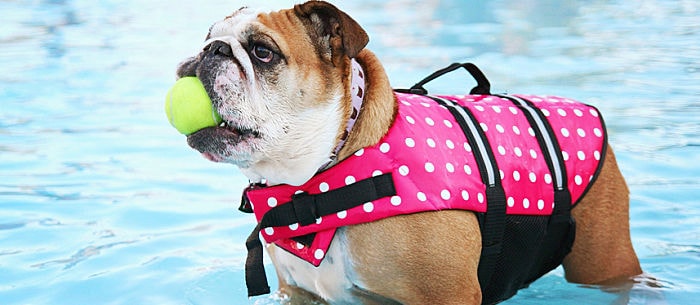Do you and your furry friend like to enjoy some fun in the sun together? Though it’s great to bond while getting some fresh air, you must be sure to take the proper precautions, as heat stroke in dogs is a completely preventable but potentially fatal condition.
Older dogs and certain breeds may be more susceptible to heat stroke, but no dog is immune, so it is essential that you arm yourself with all the facts necessary to keep your pet safe and sound. Here’s everything you need to know about avoiding heat stroke for your dog or the dogs you watch.
Why Do Dogs Get Heat Stroke?
“People sometimes forget that dogs don’t sweat the way we do,” says Dr. Miryam Reems, a Florida-based veterinarian and critical care expert who has seen countless animals inflicted with this unnecessary ailment and is deeply passionate about helping owners keep their pets safe from it.
“Dogs don’t have sweat glands and rely on their respiratory system to cool them off through panting. This is one of the reasons why you may feel fine in high heat but your dog doesn’t and is quietly suffering. Not to mention, they’re wearing a fur coat,” says Dr. Reems, who educates dog owners on exertional and environmental heat stroke.
“Exertional heat stroke in dogs occurs when they run, play or are exercised during the hottest time of day, which in some climates, can range from mid-morning to early evening.” On the other hand, “environmental heat stroke is associated with things like leaving a dog locked in a car, where temperatures can elevate dramatically and quickly,” she explains.
If your dog is older or has a compromised immune system, he may be more at risk for developing heat stroke. Another factor that comes into play is your dog’s breed. Certain breeds, such as bulldogs, boxers or any short-snouted breeds that display loud breathing are at a higher risk.
Similarly, large breed dogs, such as Labradors, golden retrievers and Siberian huskies, should also be monitored closely, particularly as they age, because they are prone to laryngeal paralysis, a common disorder which can compromise breathing and reduce a dog’s ability to cool off through panting.
How Can You Prevent Your Dog From Getting Heat Stroke?
In an effort to prevent heat stroke, you should keep your dog in a cool, shady environment and avoid prolonged exposure to bright, unshaded areas during high heat. It is also vital to ensure that your pet always has enough cool water to drink. Dr. Reems suggests that you carry water with you at all times.
You may love exercising outdoors during hot weather, but your dog doesn’t necessarily feel the same way. “The sad thing is, people run with their dogs because they love them and want them to exercise and be healthy,” says Dr. Reems. “Yet, this can do grave harm if you don’t take precautions. Your dog will keep up with you, even if you’re rollerblading or cycling, until they collapse, because they love you, too.”
A dog’s typical body temperature is about 101 to 102.5 degrees Fahrenheit, which is higher than the average person’s temperature. Anything over 103 degrees is abnormal, and if your dog’s temperature skyrockets to 106 degrees, it is much less likely that she will recover from heat stroke.
But, thankfully, you can avoid this situation by taking the proper precautions. For instance, you should never, under any circumstances, lock your pet in an unventilated, hot place, like a car or shed. And you should never let your dog run around outdoors in hot weather for extended periods of time. And, when gauging how long it is safe for your furry friend to be outside, you should refer to the heat index, not the actual temperature, as this is a better indicator of how the elements will impact your dog.
What Should You Do if You Suspect That Your Dog Has Heat Stroke?
“There really aren’t any symptoms of heat stroke in dogs, except for excessive panting,” says Dr. Reems. “Dogs often keep going until they collapse. If you wait for more severe symptoms to manifest, like decreased urine output, rapid heart rate or confusion, it may be too late,” she cautions. “My hope is the common knowledge about heat stroke in dogs will change, saving unnecessary heartache and keeping more dogs safe and happy.”
Heat stroke is a medical emergency that requires fast action. As such, if you are concerned that your dog is suffering from this condition, you should take him to the vet or hospital immediately. The medical professionals will administer IV fluids to get your pet back into tiptop shape. On your way, you should cool your dog down by drenching him in cool — not cold — water and giving him plenty of fluids to drink.
“It may seem counter intuitive, but freezing-cold water or ice will cause your dog’s blood vessels to constrict,” says Dr. Reems. This makes it harder for your pet to cool down. According to Dr. Reems, you should also place your furry friend in front of a fan or an air conditioning unit on the way to the hospital.
Are you currently looking for a veterinarian? Check out Veterinarians: How to Choose a Vet.
Corey Kagan Whelan is a freelance writer living in New York. She shares her life with two kids and two rescue dogs.
* This article is for general informational purposes only. It is not intended nor implied to be providing medical advice and is not a substitute for such advice. The reader should always consult a health care provider concerning any medical condition or treatment plan. Neither Care.com nor the author assumes any responsibility or liability with respect to use of any information contained herein.



